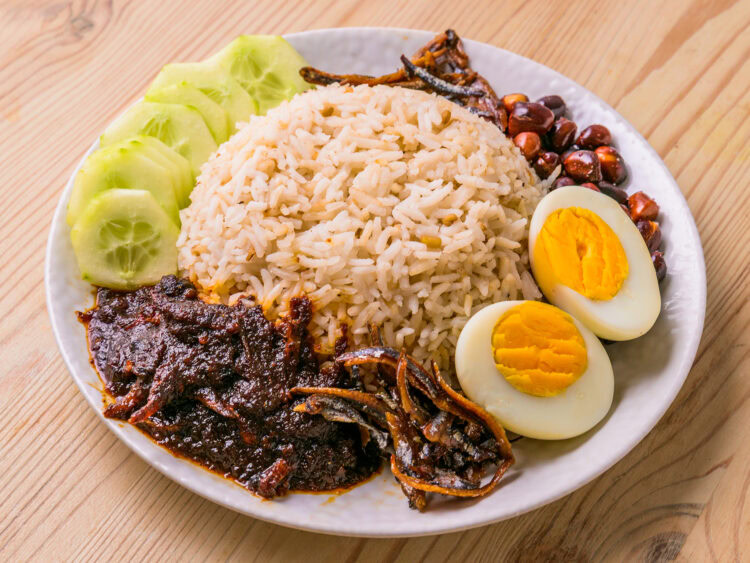A classic Nasi Lemak recipe that transports you
In Kuala Lumpur, daybreak arrives with the gentle hiss of traffic. Yet even before the city fully wakes, coconut-scented rice already perfumes the air. At a roadside stall, a vendor unwraps a banana-leaf pyramid and a cloud of steam escapes : green, grassy, and sweet with pandan.
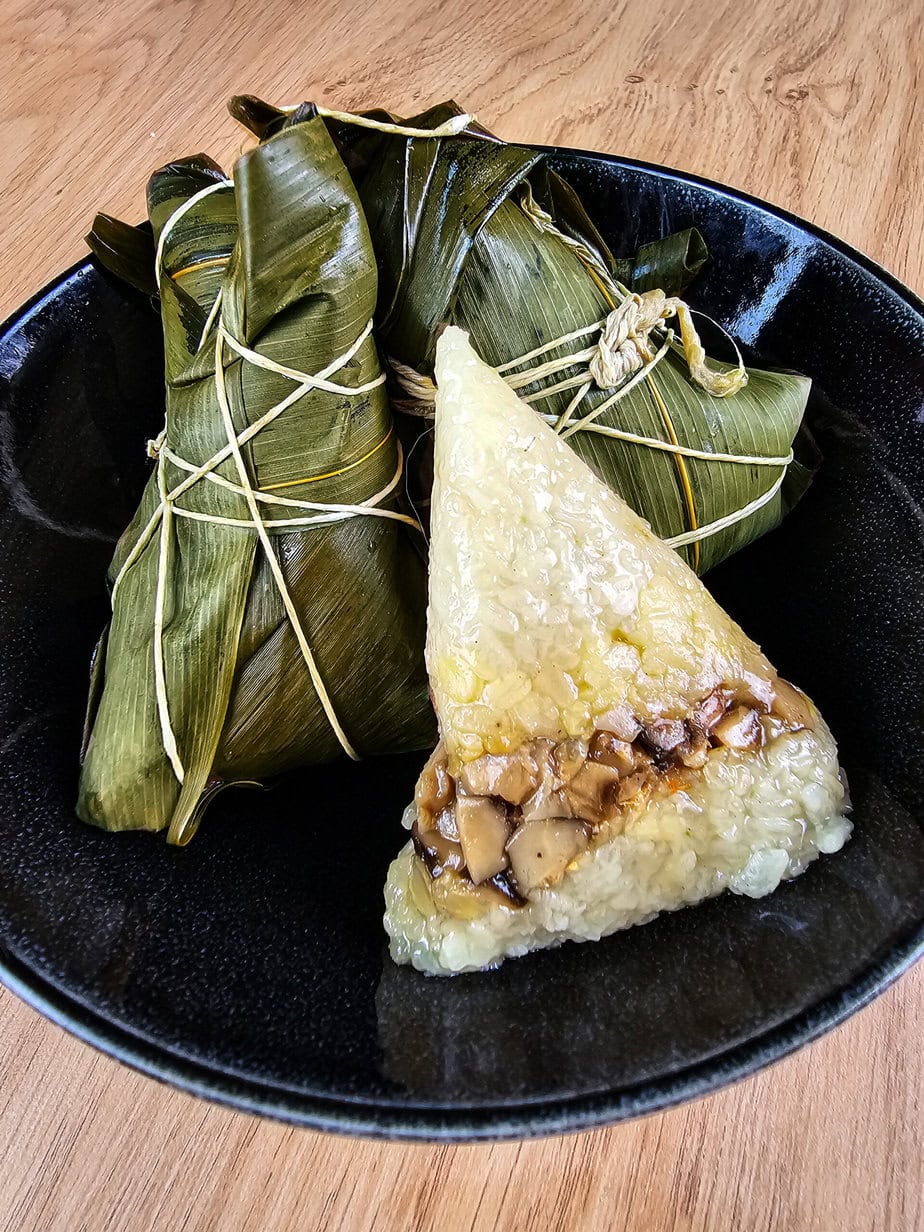
A single bite explains why Malaysians embrace nasi lemak as a national icon : impossibly rich yet perfectly balanced, a tidy bundle that nestles in the palm.
What makes nasi lemak “lemak”

Ask any street hawker : without these elements, it is just rice with extras.
- Rice with coconut : local long-grain rice simmered in thick santan, pandan, and a pinch of salt until each grain glistens.
- Sambal : a paste of dried chiles fried until the oil rises, laced with belacan and palm sugar for slow, layered heat.
- Ikan bilis : tiny anchovies fried until glassy-crisp, adding briny depth.
- Peanuts : freshly roasted with skins intact, giving nutty low notes.
- Egg : usually hard-boiled so the yolk can mellow the sambal’s heat.
- Fresh vegetables : icy-cool cucumber half-moons (or, in old-school Melaka, blanched kangkung) to slice through the richness.
The magic lies in contrast. Creamy rice meets biting spice, crispy fish balances tender egg, and every mouthful is cooled by cucumber. Purists watch for texture : the rice should be fluffy but lightly oiled, the sambal should shimmer with its own chili oil, and the anchovies should come from small local boats.
Finally, everything is wrapped in a banana leaf : a fragrant, biodegradable package that scents the meal before the first bite. We will have to skip it here, but you get the idea.
The History of Nasi Lemak
Food historians trace nasi lemak back to the 15th-century Sultanate of Malacca, when coconut palms and flooded rice paddies shared the same landscape. The first written record appears in 1909, when colonial administrator Sir Richard Olaf Winstedt mentions the “fatty rice” served at breakfast.
Farmers loved it for practical reasons : coconut cream delivered calories that lasted until the midday sun, and the banana-leaf parcel was easy to carry between rice rows. Folklore adds a domestic twist : a girl spills coconut milk into the rice, then cries “Nasi le, mak!” – “Mum, here is the rice!” – and a legend is born.
In 2024, UNESCO placed Malaysia’s “breakfast culture,” with nasi lemak as its emblem, on the Representative List of the Intangible Cultural Heritage of Humanity. The recognition merely confirmed what Malaysians already knew : more than a meal, it is a shared memory.
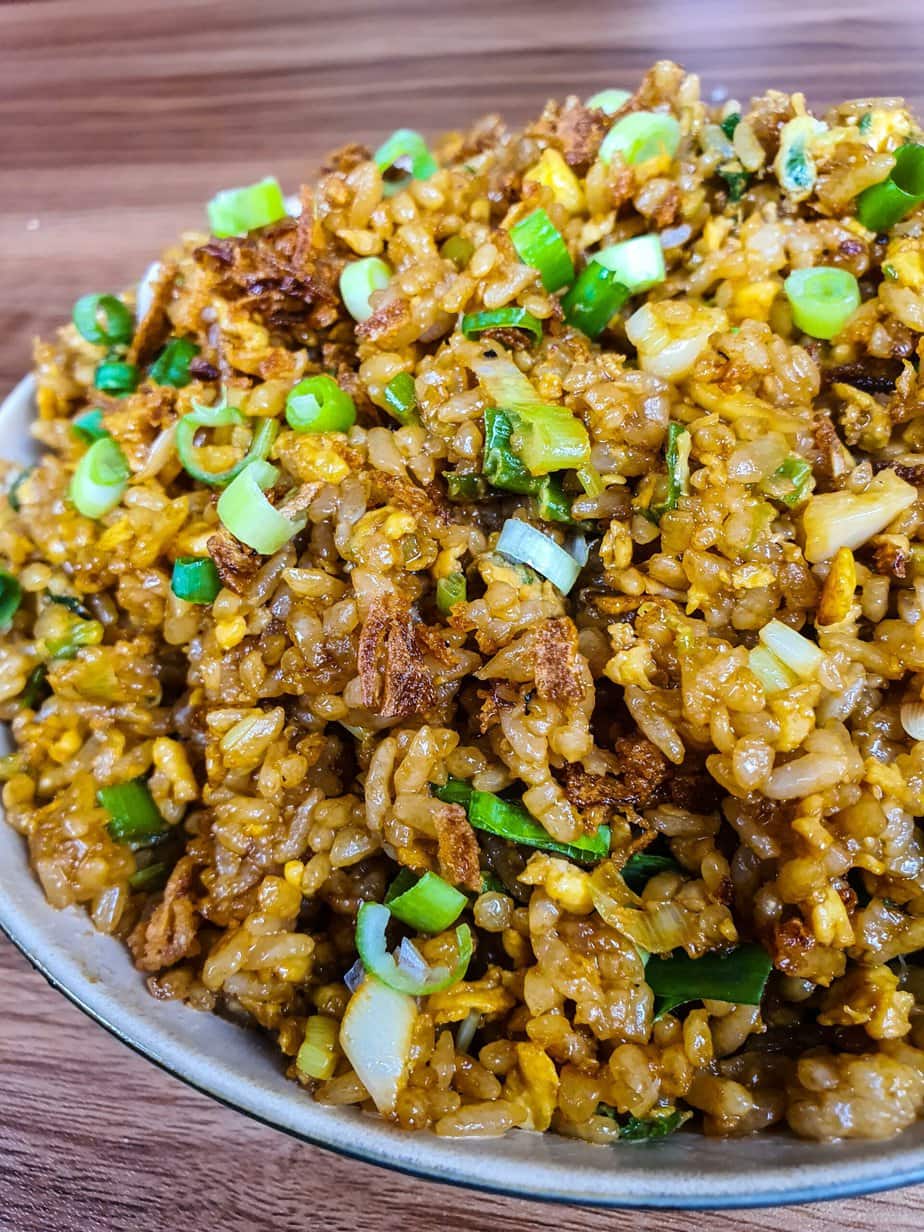
The Different Styles of Nasi Lemak
The coconut rice never changes, but the condiments reflect local terroir :
- Johor : a few fenugreek seeds perfume the rice, while a sambal tumis walks a tightrope between sweetness and acidity.
- Melaka : cucumber gives way to fine emerald strips of kangkung, and the sambal stays fiercely unsweetened.
- Klang Valley : no plate seems complete without a serving of spicy fried chicken – so common that city dwellers forget it is an extra.
- Kedah et Perlis : turmeric tints the rice yellow for Nasi Lemak Royale, then it is ladled with various curry sauces.
- Terengganu : the parcel hides tuna stewed in a spicy sauce, adding coastal depth.
- Kelantan : layers of rice, shredded dried fish (serunding ikan) and curries are packed into a cone called Nasi Lemak Tumpang.
- Sabah et Sarawak : preparations stay classic but showcase the local belacan.
So, what is a true Nasi Lemak?
Contemporary Malaysia happily embellishes its breakfast : fried chicken, beef rendang, or sambal sotong are welcome luxuries as long as the sacred six remain. Anyone who pushes the transformation too far can expect social media to erupt.
Coconut-light rice, supposedly healthy? A chorus of “Ini bukan nasi lemak!” rises. No sambal or a sloppy sambal? Expect a meme avalanche.
Brown-rice versions receive polite tolerance; butterfly-pea or quinoa riffs are usually labeled “fusion.” Diaspora kitchens adapt to what is on hand: anchovies turn into sardines, kangkung gives way to lettuce; yet even abroad the rule holds : the rice must taste of coconut and the sambal must burn.
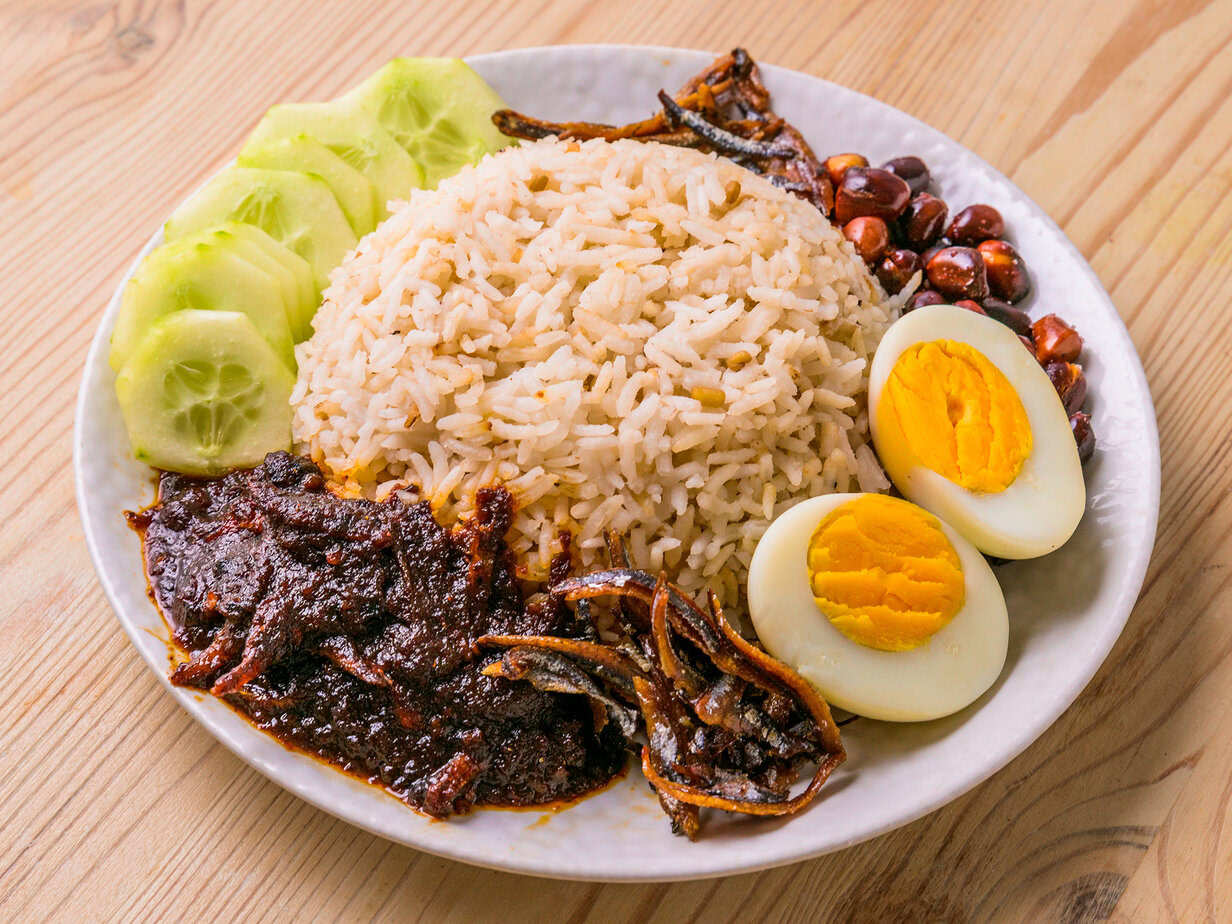
Authentic Nasi Lemak
Equipment
Ingredients
Coconut rice
- 2.4 cm ginger
- 2 shallots
- 0.5 stalk lemongrass lightly crushed
- 2 leaves pandan leaves torn and knotted
- oil for sautéing
- 0.5 stick Chinese cinnamon
- 1 star star anise
- 380 g jasmine rice dry weight
- 710 ml liquid one-third coconut milk, the rest water
- 0.25 teaspoon fenugreek seeds
- salt to taste
Sambal tumis
- 4 shallots puréed
- 3 cloves garlic puréed
- 2.5 cm ginger puréed
- 1 large onion puréed
- oil for frying
- 0.5 large onion sliced
- 2 leaves pandan leaves torn and knotted
- 3 tablespoons chili paste (cili kisar)
- water a little
- 1 tablespoon oyster sauce
- 1 teaspoon fish sauce
- 40 g palm sugar or coconut sugar, add to taste
- salt to taste
- 0.5 medium onion sliced
- 0.5 handful dried anchovies for frying
Garnishes
- peanuts roasted
- dried anchovies for frying
- hard-boiled eggs
- cucumber
Instructions
Nasi lemak rice
- Finely slice the shallots and ginger.2 shallots, 2.4 cm ginger
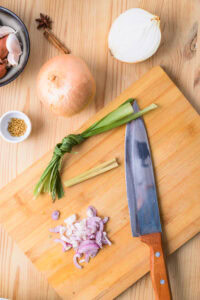
- Lightly crush the lemongrass stalk.0.5 stalk lemongrass
- Tear, then knot, the pandan leaves.2 leaves pandan leaves
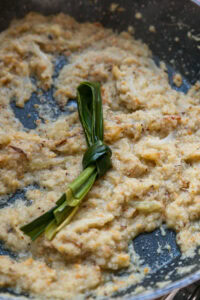
- Heat a little oil in the rice-cooker bowl.oil
- Sauté the shallots for a few moments.
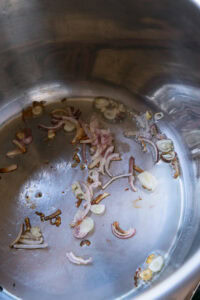
- Add the ginger, lemongrass, and pandan, and cook until fragrant.
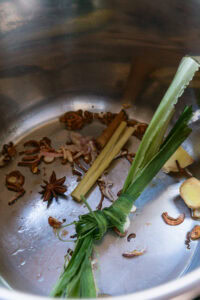
- Stir in the cinnamon and star anise.0.5 stick Chinese cinnamon, 1 star star anise
- Add the washed and drained rice; mix well.380 g jasmine rice
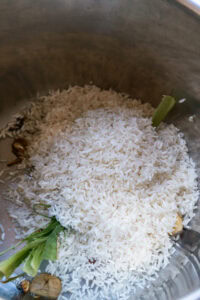
- Pour in the liquid at a ratio of 1 part rice to 1.5 parts total liquid, using one-third coconut milk and the rest water.710 ml liquid
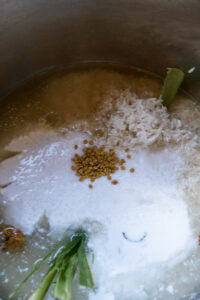
- Add the fenugreek seeds.0.25 teaspoon fenugreek seeds
- Season with salt to taste and stir.salt
- Close the rice cooker and let it cook.
Sambal tumis
- Roughly chop the shallots, garlic, ginger, and onion.4 shallots, 3 cloves garlic, 2.5 cm ginger, oil
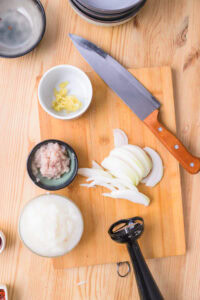
- Fry the dried anchovies until crisp.
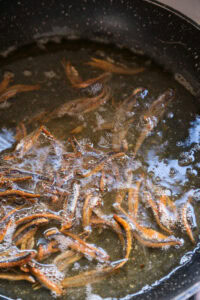
- Tip the fried anchovies into a blender with a splash of water and blend until very smooth.1 tablespoon oyster sauce

- In the same oil, fry the peanuts over low heat until golden, then lift them out.0.5 large onion, dried anchovies
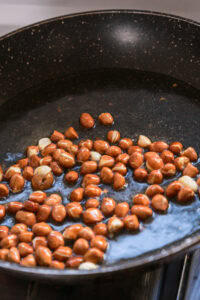
- Fry the remaining anchovies and set aside.hard-boiled eggs
- In the same oil, sauté the sliced large onion.2 leaves pandan leaves
- Add the spice purée prepared earlier.
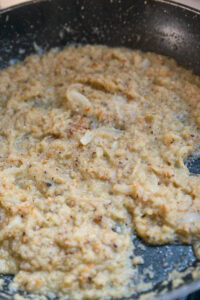
- Cook, stirring, until the paste dries out and starts to brown.
- Add the knotted pandan leaves.3 tablespoons chili paste (cili kisar)

- Stir in the chili paste (cili kisar).water
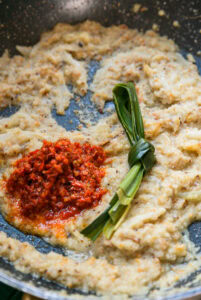
- Cook until the sambal is deep red and the oil splits (pecah minyak).

- When the mixture dries out, add a splash of water and let it reduce again; repeat at least three times to build flavour.
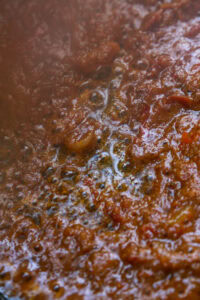
- Stir in the oyster sauce and fish sauce, then add the palm sugar a little at a time.1 teaspoon fish sauce, 40 g palm sugar, salt
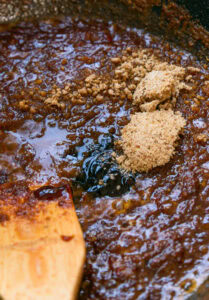
- Add another splash of water to help the sugar dissolve.
- Fold in the fried anchovies and sliced medium onion; cook briefly until the onion softens.0.5 handful dried anchovies
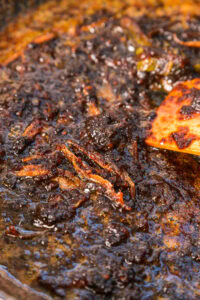
- Season with salt to taste.0.5 medium onion
Serving
- Slice the cucumber for garnish.
- Plate the coconut rice with sambal tumis, peanuts, fried anchovies, and hard-boiled eggs.cucumber
Notes
- To judge the heat of the chili paste, dab a little on your fingertip and taste. If it’s too mild, stir in another ladle or two.
- Great sambal needs oil—let the chilies fry until completely cooked through.
Nutrition
Culinary Sources
- Nasi lemak – Wikipedia (English)
- Nasi lemak – Wikipedia (Malay)
- Fun facts about nasi lemak – Horizon Art Fair (English)
- Article « Food ethics: past and present practices of Malaysian culinary heritage » – StuDocu (English)
- Nasi lemak: an origin story – BURO (English)
- Breakfast culture in Malaysia: dining experience in a multi-ethnic society (English)
- Recipe: fenugreek nasi lemak (Johor) – Ajinomoto (English)
- 5 types of nasi lemak in Malaysia to know – Ajinomoto (English)
- “Nasi lemak! Hope you’ll like it!” (no peanuts, allergy) – Reddit (English)
- Local food tales: nasi lemak, Malaysia’s second mom – Espoletta (English)
- A Westerner sells nasi lemak in the United States – Reddit (English)
- “It’s super delicious!” – Cari Forum (Malay)
- Secrets of a tasty nasi lemak and long-lasting sambal – Facebook (Malay)
